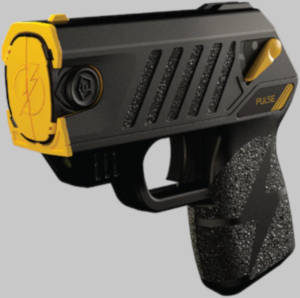A Brief History of Stun Guns: How They Became Popular Self-Defense Tools
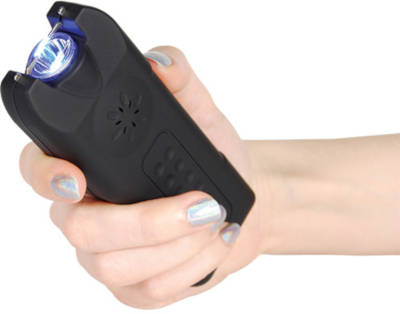
As a responsible and safety-minded citizen, arming yourself with the knowledge of self-defense tools is always a wise decision. The invention of Stun Guns revolutionized safety and self-defense tactics and have become one of the most popular self-defense tools available today. But where did Stun Guns come from, and how did they become that popular? Join us on this journey as we look into the origin and evolution of Stun Guns down to their current popular status.
Quick Explanation
Modern stun guns were invented in 1974 by American physicist Jack Cover as a non-lethal self-defense weapon. Since then, they have been used by law enforcement and civilians in many parts of the world.
Introduction to Stun Guns
The term "stun gun" is often used in a broad sense to describe any self-defense tool that uses electrical shock to incapacitate an attacker. Stun guns have been around for more than a century and have evolved from bulky, relatively crude devices to compact, sophisticated models. Used judiciously, stun guns can be effective non-lethal tools of self-defense.
Opinions on stun guns are divided. Supporters of their use cite the advantage of attacking without causing physical harm to the assailant or struggling with them in close quarters. Meanwhile, critics argue that authorities can misjudge the level of force needed for a situation and deploy stun guns inappropriately. Additionally, there are issues surrounding the prolonged effects of prolonged exposure to electric shock as well as potential risks from malfunctioning products on the market.
The next section will discuss the earliest inventions of an electric shock device, which laid the foundation for modern stun guns.
First Electric Stun Gun Inventions
No discussion about the beginnings of stun devices would be complete without mentioning the first capacitor. The Leyden jar is an electrical capacitor invented in the 18th century and played a key role in the development of stun devices. The jar consists of a glass or ceramic container coated inside and outside with metal foil. A metal rod or wire is inserted through a cork or other insulating material into the jar, with one end making contact with the inner foil and the other exposed.
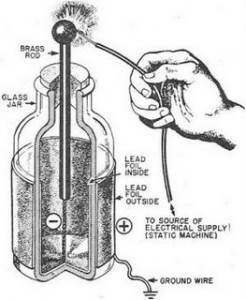
Leyden Jar
When a high voltage is applied to the exposed end, it creates a charge imbalance between the inner and outer foils, allowing the jar to store electrical energy. The Leyden jar was a crucial component in early electrostatic generators and played a key role in the development of early stun guns and other non-lethal weapons.
Some early stun gun-type devices included:
- Electric Baton - Invented in the early 1930s, the electric baton was a handheld device that delivered an electric shock to incapacitate an attacker. It was primarily used by law enforcement agencies.
- Spring Gun - Invented in the early 1930s by physicist John Burton-Page, the spring gun was a humane way to stun animals before slaughtering them.
- Electric Shield - Developed in the 1950s, the electric shield was a large, handheld device that delivered an electric shock to incapacitate an attacker. It was used by law enforcement agencies and the military.
- Electric Cattle Prod - Perfected in the 1930s, the electric cattle prod was used to shock cattle into moving or following commands. It was later adapted for use by law enforcement agencies as a non-lethal weapon.
- Stun Glove - The stun glove is an early precursor to the modern stun gun that was developed in the 1930s. It was a wearable device that resembled a glove and was designed to deliver a shock to an attacker. The stun glove consisted of a leather glove with metal plates or wires sewn into it, which were connected to a battery or other power source.
Jacob’s Cattle Prod - Jacob’s Cattle Prod was one of the earliest iterations of a stun gun in existence. Developed by cattleman Jacob Fafoglia in the 1920's, this device was originally designed as a tool to prod herds of cattle during herding and slaughtering operations.
Later, the design was improved upon by a Chicago inventor named Paul D. Humes in 1930. Humes developed a handheld electric shock device that he called the "Hot Shot" to aid in the handling of livestock, particularly cattle. The device consisted of a long, insulated handle with an electrode at the end that could deliver a high-voltage, low-amperage electric shock when pressed against the animal's skin.
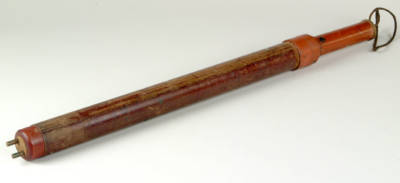
Cattle Prod
Although some people found comfort and security in owning such an item for protection against potential attack and harm, not everyone shared the same enthusiasm. Critics argued that the safety benefits were largely outweighed by the potential for misuse by criminals, especially since many criminals lacked the reservation that most law-abiding citizens exercised when it came to actually carrying out acts of physical violence with them. This led to many states instituting regulations at both state and local levels limiting the sale of these devices.
In spite of these regulations, the cattle prod remained popular in some circles as an effective self-defense tool, albeit with some aspects of risk attached. As technology progressed down the years and more efficient means of personal safety were developed, these early devices eventually became overshadowed as attention shifted to newer generations of stun guns designed specifically with self-defense in mind.
Stun Glove - One of the earliest known examples of a stun glove was developed by William H. Smith in the 1930s. Smith was a police officer in Berkeley, California, and he developed the glove as a non-lethal alternative to using firearms. The glove was powered by a 12-volt battery and was capable of delivering a shock of up to 500 volts. The stun glove was designed to be used by law enforcement officers and other security personnel as a means of subduing violent or dangerous individuals without causing serious injury.
However, the device had limited effectiveness and was never widely adopted due to its cumbersome design and the potential for accidental injury to the wearer. Despite the limitations of the stun glove, it represented an important milestone in the development of non-lethal weapons technology. The basic concept of delivering an electric shock to incapacitate a target would be refined and improved over the years, leading to the development of the modern stun gun.
Stun Device Controversy
While these early devices paved the way for the modern stun gun, they were often bulky, difficult to use, and not as effective as modern stun guns. Today, stun guns are compact, lightweight, and highly effective at incapacitating attackers. They are widely used by law enforcement agencies and individuals for self-defense purposes.
However, stun guns were not without controversy; some argued that they should be banned due to their ability to cause harm or kill individuals who come into contact with them. Inventors struggled with improving safety features on the device, such as circuit breakers and automatic shutoff switches, while opponents pushed for complete outlawing of such weapons. Supporters argued that stun guns are beneficial in defending oneself against attackers and helped reduce levels of violence in prisons.
Eventually, after much debate, the use of stun guns was adopted by many police departments throughout the world as nonlethal weapons for self-defense and crowd control.
Today, modern versions remain popular among law enforcement personnel and civilians alike thanks to their high level of efficiency and notably powerful shocks.
The next section will discuss Jack Cover's Taser, an influential device that helped shape modern stun gun technology and increase its popularity among citizens looking for an alternative method of protecting themselves without having to resort to lethal force.
Jack Cover's Taser
Jack Cover's Taser is the device that most closely resembles modern stun guns and it changed the course of self-defense tools. Development began in 1969 and he named it the Taser after a character he read about as a youth. Taser stands for "Thomas A. Swift's Electric Rifle."
The Taser was one of the first nonlethal weapons to use electrical pulses to protect its user from an assailant. It works like a handheld firearm, with a trigger and two prongs that fire out electric current when the device is activated. Although initial models had limited range, it could still be used safely to protect oneself at close range, protecting the user from possible injury and giving them time to escape.
The effectiveness of the Taser as a self-defense tool has been heavily debated due to its potential consequences on human health and safety if used excessively. Critics argue that while Tasers may be better than other forms of force such as firearms or physical assault, they can still cause serious injury if used improperly. Opponents also point out that there have been numerous fatalities which were linked to either excessive use of Tasers or improper training in their use, making them potentially dangerous when deployed by untrained users.
Overall, Jack Cover's Taser quickly became popular for use in self-defense, though its effectiveness has long been debated due to its potential consequences on human health and safety. Its success helped pave the way for other forms of nonlethal weapons such as stun guns and pepper spray, giving us the ability to protect ourselves while avoiding the risk of serious harm caused by more lethal weapons. Next, we will explore another key piece of this puzzle – how stun guns came into law enforcement usage.
Law Enforcement Usage of Stun Guns
Law enforcement usage of stun guns has been widespread since their introduction in the 1970s. In many cases, stun guns are seen as an alternative to deadly force, giving law enforcement officers an additional tool for self-defense, apprehending suspects, and other policing duties. Although there are benefits of using these non-lethal weapons for law enforcement applications, drawbacks have been widely debated in recent years.
The most common benefit is that when applied properly, a stun gun offers the potential to significantly reduce injuries and death due to police interactions — both the suspect’s and those of officers. When used instead of firearms or other forms of lethal force, they can help de-escalate tense situations without sacrificing officer safety.
On the other hand, there are still dangers associated with improper use of stun guns. Excessive use – or continued jolting after initial contact - can result in serious injury or even death when applied on vulnerable individuals such as pregnant women, elderly people, or children. This can lead to legal implications for the Law Enforcement Agency and questions about their policing practices. And for some individuals, particularly those with mental health issues, simply the sight of a stun gun can be enough to trigger a person into panic and create a dangerous situation for everyone involved.
Despite these risks, it’s clear why stun guns continue to be popular tools in law enforcement and have established a role alongside other non-lethal means of defense such as pepper spray and batons. Moving forward, continued research should be done on the proper use of stun gun technology in order to maximize safety for both police and civilians alike.
With this important debate in mind about stun guns in law enforcement, we turn our attention next to their increasing popularity as self-defense tools outside of professional environments.
- The first stun gun was developed by a man named Jack Cover in 1974 and was patented in 1983.
- It has been estimated that 600,000 police officers in the United States regularly use tasers.
- According to a US Department of Justice study, incidents involving the use of stun guns decreased 21 percent from 2002 to 2007.
Stun Guns in Self-Defense and Protection
Civilians have used stun guns since the late 70s as a tool of self-defense. By using an electric current to disrupt muscle function, stun guns are considered non-lethal and useful for protective measures against potential assailants.
At the same time, stun guns also have their fair share of critics due to their strength and intensity. The shock from a stun gun can be incredibly painful and inflict vigorous disorientation and nausea without lasting effects. As a result, there has been some debate about whether or not this kind of self-defense is necessary or warranted in certain cases. Supporters of stun gun use argue that having access to such a weapon could make the difference between life and death in situations where people feel threatened or afraid -especially women who may feel they are defenseless against physical attackers.
Critics point out that the power of a stun gun gives someone too much control over another individual's body. They also worry that inexperienced users might end up doing more harm than good if they employ it excessively or use more than necessary force when attempting to defend themselves.
Leading into the next section, modern stun gun technologies and features provide additional protection for those seeking extra security while still giving users the confidence they need in case of emergency.
Modern Stun Gun Technologies and Features
Modern stun gun technologies have come a long way since their first introduction. Today, they are available in multiple sizes and functions. These include pocket-size tasers with barbs or probes that deliver an electric shock to the target from a distance of up to 25 feet, as well as other styles such as flashlight models or simple non-lethal air guns.
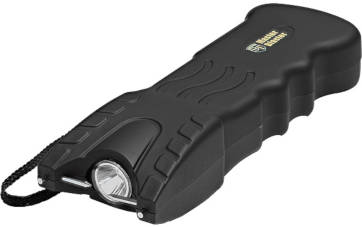
Example of a modern stun gun
Modern stun guns employ different types of engineering techniques, including capacitance discharge technology. This technology stores electrical charge in a capacitor until it is fast-discharged through the target contact prongs. The effects of this rapid flow of energy can induce unconsciousness within seconds, sometimes rendering the victim temporarily paralyzed by shock.
Additionally, many modern stun gun models feature safety features that reduce accidental injury to the operator. This includes safety switches to prevent accidental discharge, an anti-snatch mechanism to prevent unwanted access and use, and a spark gap which creates a visible arc between the two prongs when deployed.
The use of modern stun guns has sparked debate in terms of their efficacy and their potential for abuse due to their simplicity and low cost. Supporters argue that non-lethal self-defense alternatives like modern stun guns play an important role in crime prevention; opponents say that misuse can lead to unnecessary pain, physical or psychological trauma, or even death if not handled properly.
As new advances are made in engineering and design, the capabilities of these devices expand exponentially. With that in mind, let's take a closer look at one particular type of stun gun: flashlight stun guns.
Flashlight Stun Guns
The development of flashlight stun guns has made self-defense tools more accessible and easier to use. Flashlight stun guns, also known as flashlight tasers, are multifunctional weapons, with a flashlight and a built-in stun gun that provides an electrical charge of up to several million volts. Unlike other stun guns, flashlight stun guns have the added benefit of providing light in dark areas, which makes them particularly useful for self-defense in low-light or unfamiliar areas.
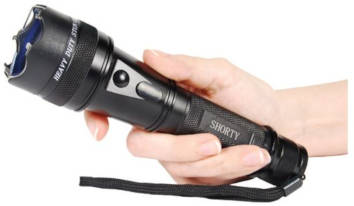
Flashlight Stun Gun Held in Hand
Flashlight stun guns are commonly used by law enforcement personnel, security guards, and private individuals who want an easy-to-use and effective way to protect themselves. The advantages of flashlight stun guns are mainly that they can be carried on your person in all legal jurisdictions, as they have both a useful purpose as an ordinary household object (a flashlight), and they can disable an attacker very quickly with their electric shock.
However, there can be risks associated with their use. For example, there is a potential danger associated with carrying a single device that has two functions - not only could you mislead someone into thinking it is just a regular flashlight, but any misuse of such devices can be potentially dangerous. Further consideration should be taken at all times when using or considering using a flashlight stun gun as a self-defense tool. Additionally, specific legal restrictions may apply in different countries or states surrounding the acquisition and usage of these particular devices.
Ultimately, it is important for each individual to assess their personal safety needs and understand exactly what the laws are in their area around the ownership and usage of non-lethal weapons such as flashlights stun guns before making any decision to use one for self defense.
Common Questions and Answers
What are the benefits of stun guns and why are they popular?
Stun guns are popular self-defense tools due to their many benefits. They are non-lethal and typically require very little physical strength to use, making them an ideal choice for individuals who cannot or do not want to employ more deadly force. They can be used from a distance, making them useful for escaping an attack or intimidating an assailant without engaging in close quarters combat.
Stun guns also provide a psychological benefit because they create a loud noise that can surprise and disorient assailants and aid the defender in quickly gaining control of the situation. Furthermore, stun guns cause electrical shocks that temporarily impair muscle activity, giving the target time to flee or call for help.
Lastly, stun guns are relatively inexpensive compared to other forms of self-defense, making them accessible to people with a wide range of budgets. For all these reasons and more, stun guns remain popular self-defense tools.
How have stun gun laws evolved over time?
The laws related to stun guns have evolved significantly since they became popular self-defense tools. Originally, most jurisdictions prohibited the possession of electrical weapons of any kind, including stun guns. However, these prohibitions were gradually relaxed in many jurisdictions as the use of stun guns for self-defense became more widespread.
Stun gun laws now vary greatly from state to state, with some states, such as Pennsylvania and Massachusetts, allowing unrestricted use while others, such as Hawaii and Rhode Island, generally prohibiting them. In addition, many states have enacted age restrictions and required permits or licenses for ownership or use. Federal regulations also restrict the importation and transportation of stun guns across state lines.
Critics of stun gun laws continue to argue that they should be further relaxed so that individuals may exercise their right to self-defense without fear of legal repercussions. Still others contend that further restrictions are necessary in order to protect individuals from potential misuse or abuse of Tasers and other electrical weapons. Ultimately, it will be up to individual legislatures to decide how best to regulate the use and possession of these powerful personal defense tools.
What are some of the challenges and controversies associated with stun guns?
Stun guns can be highly controversial. On the one hand, they are popular non-lethal self-defense tools, preferred by many civilians due to their effectiveness and low risk of injury or death. On the other hand, they have become more accessible in recent years, leading to some concerned over potential misuse and potential increase in incidents of violence involving stun guns.
One of the main challenges associated with stun guns is their potential for misuse. Stun guns are weapons and thus require a certain level of responsibility and discretion when using them as self-defense. In the wrong hands, stun guns can be lethal and have even been tied to fatalities, making it essential that those using them act responsibly.
Another challenge that has faced the use of stun guns is regulation. Recently, several cities have passed laws banning personal possession of stun guns, while other states have age restrictions in place to ensure minors do not carry stun guns. In some cases, these regulations can make it difficult for individuals to access a self-defense tool and protect themselves from harm.
Lastly, there is an ethical debate about whether or not citizens should be able to arm themselves with such potentially dangerous weapons as electric stun guns. Proponents argue that stun guns are beneficial for self-defense purposes and having them available for use could help reduce crime. Opponents view stun guns as dangerous devices that only serve to escalate violent incidents, endangering both the attacker and victim alike.
These relevant challenges and controversies need to be considered when think about the usage of stun guns and any related policies going forward.
What are the most popular types of stun guns today?
Today, the most popular types of stun guns are small, handheld devices. These smaller devices are often referred to as "tasers." The initial TASER design was developed in the 1970s and has since become wildly popular as a self-defense tool due to its effectiveness in disabling an assailant with minimal risk of injury.
In addition to these smaller devices, larger "stun batons" have become popular with law enforcement officers and private citizens. These baton-style stun guns can be up to 24 inches long and deliver an enormous shock.
Finally, there are miniature stun guns designed for keychain use, usually slightly larger than a standard-size keyset. Many people choose such devices as they are easily accessible and can be used to quickly disable potential attackers.
While devices differ, their terminology remains similar. Check out our glossary of stun gun terms post.
Overall, while personal preferences vary widely when it comes to stun guns, the three most popular types today remain TASERs/smaller hand-held devices, stun batons, and keychain versions.
How long have stun guns been in use?
Stun guns have been in use since the 1970s. Initially, they were developed by Jack Cover, a NASA scientist. Cover's device was called the Taser – an acronym for Thomas A. Swift Electric Rifle – and was named after the fictional character Tom Swift from the children's book series. This early form of stun gun fired two darts connected to wires that could transfer an electrical current between them, causing over-stimulation of the muscle nerves and temporarily disabling someone’s ability to move or defend themselves.
Since then, stun guns have become increasingly popular as non-lethal self-defense tools. As research into their effectiveness continued, various modifications and improvements in design have been made over the years so that today stun guns range from small hand-held devices to larger models able to fire multiple shots at once. In addition, advancements in technology such as microchips and rechargeable batteries have led to greater safety standards and improved reliability of these weapons.
Overall, stun guns have been used for nearly 50 years and continue to be an effective solution for personal protection without causing serious harm.
Add your comment now!
Post Comment
